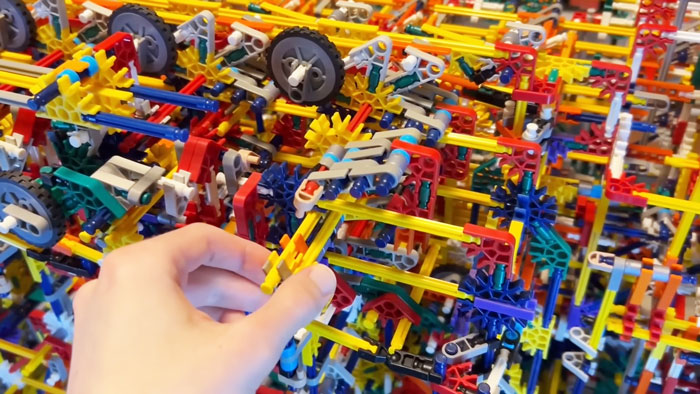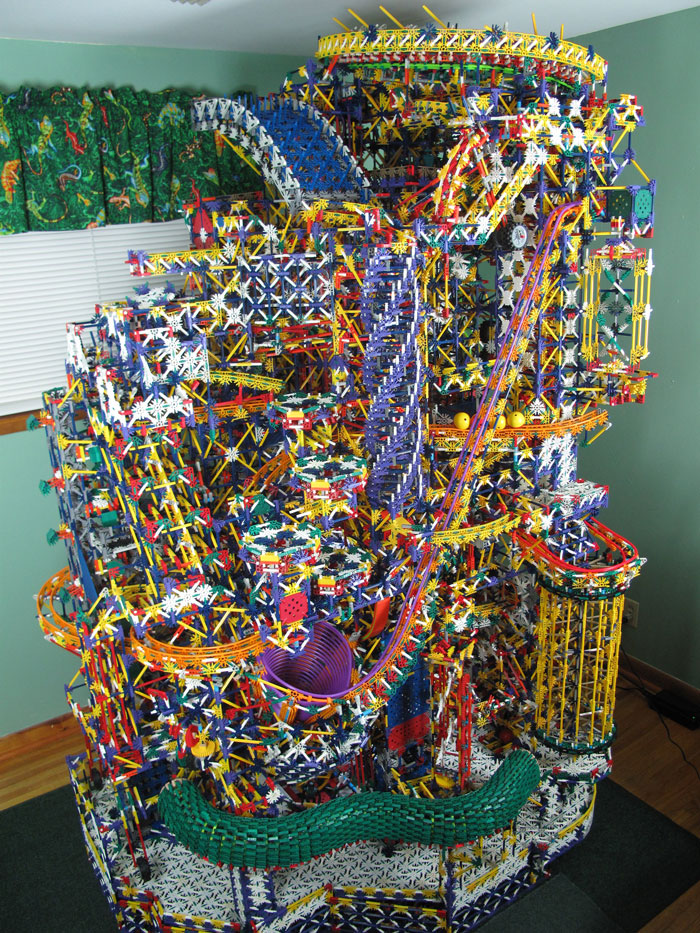A man has gone viral after building a fully functional 8-bit computer out of K’Nex.
In a video that has now amassed over 112,000 views, Kyle, known online as Shadowman39, debuted the Arithmetic and Logic Unit, or ALU, and showed how it processes and computes information in 8-bit binary.
Now, in an exclusive interview with Bored Panda, the enthusiast has provided detailed insight into the computer’s construction and the future of the project.
The computer can add numbers from 0 to 255

As an 8-bit computer, Kyle’s invention processes information in strings of eight binary values. Digitally, this means a 1 or a 0, but in this case, a pulled-out K’Nex rod is a 1, while a pushed-in rod is a 0.
In other words, eight pulled-out rods is the equivalent of 11111111, or 255 in decimal notation.
As an Arithmetic Logic Unit, the contraption is capable of combining two input numbers to find the sum. “All it does is take two input numbers and has an output,” Kyle states in his video.

“The main thing that it will do is add two numbers.” These two input numbers are first stored in two separate 8-bit storage banks, called the A and B registers, before the calculation begins. The result is then stored in a third bank, the Sum register.
All of this requires the machine to perform functions normally handled by circuits in electronic computers. These include the AND, NOT and XOR functions.
It does all this in an amazingly compact package. Kyle revealed it’s only about four feet tall and three feet wide.
An 8-bit computer is a unique and ambitious project in the K’Nex community

Kyle’s presence in the online K’Nex community dates all the way back to 2008, when he started the Shadowman39 YouTube channel while still in middle school. However, the 8-bit computer represents a significant departure from his usual projects.
Most of his videos feature “ball machines,” complex contraptions that guide balls along elaborately constructed tracks. The Tennessee-based engineer decided to attempt a mechanical computer after watching another popular YouTube channel.

“The main thing that made me want to make a mechanical computer was I watched Ben Eater’s 8-bit breadboard computer series on YouTube, which is pretty popular,” Kyle explained.
“I was like, ‘You know, maybe I can make this out of K’Nex and make it purely mechanical.’ While watching that series and learning about how computers work, I was thinking in the back of my mind, ‘How would I make this part work mechanically with a physical model?’”
Kyle decided to challenge his engineering prowess as much as possible with the compact 8-bit design

While the YouTuber might make it look easy, it’s several leaps ahead of what had previously been attempted with K’Nex. Few similar projects exist, with the most notable being a 1-bit adder from around a decade ago.
“It was about the size of a small refrigerator and it took probably a minute just to get 1+1 equals two,” Kyle revealed. To create an 8-bit version of that design, you would need eight of those massive units.
Unlike past designs, Kyle’s computer is unique in its efficiency and compactness. “A 1-bit adder takes 10 to 15 logic gates, and then you have to multiply that by eight. So at that point, it’s just infeasible.”
Instead, he invented his own systems from scratch. “This thing is totally custom,” he told us. “Lots of the methods and mechanics that I use, I invented all of those.”
However, making it so compact made it difficult to build and even more difficult to update or fine-tune. He often has to take it partially apart to make adjustments. “It’s like working on a car engine where you have to remove stuff just to get to the center of it,” he admitted.
Shadowman39 is part of a surprisingly large and active K’Nex community

Kyle’s own K’Nex journey began when he got a roller coaster set as a kid. “After that, I guess I was hooked,” he recalled.
Eventually, Kyle took this love of complex systems to college, where he studied mechanical engineering. Now, he works in software engineering, where his multidisciplinary mind informs his projects like the mechanical computer.

He notes that the K’Nex community has been able to survive thanks to the internet, despite the toy’s waning mainstream popularity and loss of market share to rivals like Lego. Nevertheless, the community has faced increasing challenges.
A few years ago, the K’Nex company was sold, so enthusiasts can no longer order parts directly from the website. However, these challenges appear to have only pulled the community closer together.
Almost entirely online with presences on forums like Reddit and Instructables, as well as YouTube, the hobby brings the like-minded together. “Most of the people that I know of are from online,” Kyle said, speaking about his fellow enthusiasts. “Sometimes we meet up if we’re traveling.”
Kyle wants to add more parts like RAM to his ALU and potentially make computers with larger bit strings
Kyle is wasting no time with the next phase of his project. He’s already working on RAM, or random access memory, which would allow the machine to remember previous information and calculations. After that, he would like to create a visual display with counter wheels that would allow someone using the computer to more easily interpret the output.
With future additions, the engineer hopes to transform the computer into a more powerful device capable of running simple programs. For example, once the RAM is integrated, he says it should be able to calculate the Fibonacci sequence and exponents, as well as determine whether a number is prime.

Meanwhile, the K’Nex whiz already has his mind on ambitious future projects.
“With this computer, I’m already thinking of a version two that’s a lot better,” he revealed. He is considering two possible paths for his next major project: either building a more powerful 16-bit computer or designing a new 8-bit model that is significantly “faster so it can process bigger numbers in the same amount of time.”
In the meantime, keep an eye out for his next update.
K’Nex fanatics are going wild over Kyle’s “genius” feat





















